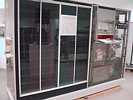Return to "Visible Storage"
*** Please note: This website (comp-hist) was completed before I found out about Wikipedia in 2002.
Since then I have added material occasionally.
Items are certainly not complete, and may be inaccurate.
Your information, comments, corrections, etc. are eagerly requested.
Send e-mail to Ed Thelen. Please include the URL under discussion. Thank you ***
UNIVAC Solid State
Manufacturer UNIVAC Identification,ID UNIVAC Solid State Date of first manufacture - Number produced - Estimated price or cost - location in museum - donor - Contents of this page:
- Photo
- Placard
- Architecture
- Special Features
- Historical Notes
- This Artifact
- Interesting Web Sites
- Other information
Photo
UNIVAC ???
from Larry Blanchard
The Univac photo you show with the question marks is, IIRC, an SS-80 or SS-90 (80 or 90 column cards). We got one at Appliance Park around 1960 or so as a subsidiary and for evaluation as a possible replacment for our Univac II. from Hans Neukom, May 14,2010
-
-
- Historical Notes
- This Artifact
-
Subject: Univac Solid-State 80/90
From Dan Entingh
Mon, May 25, 2015
Dear Ed, I really like your site. I've been into electronics since I was a little kid. Over the years, (I'm 63 now) I've amassed quite a collection of books and "legacy Items" (girlfriend calls it "my junk") pertaining to obsolete technology, Bell System, Cold War, etc. Thanks to photos on your site, I've identified a few of my items as likely components of Nike-Ajax systems.
I'm writing in reference to your Univac Solid-State page: http://ed-thelen.org/comp-hist/univac.html
I worked on one of these machines just out of High School, around 1970 to 1974. This was in a small town in southeast Colorado. A friend of mine's Dad made a deal for two complete systems. These had originally been owned by Safeway Stores Inc., and removed when they upgraded. We also got all the books, drawings, and support equipment such as key punches, interpreters, sorters, collators, etc. The computers were made in 1959. We were able to get one system working and used it to do card entry, tape storage and printout of inventory records. A few years later, when a local utility began selling computing services, the data was moved over there, and the old Univac was sold for scrap. They used a lot of gold contacts in those old computers.
The Univac Solid-State Computer came in two versions, 80 and 90 column. The 80 column systems used the same type punch cards as IBM, but we had the 90 column version. The 90 column cards were the same physical size as the 80s, but divided into an upper and lower zone, with 45 columns of round holes in each zone. Unfortunately, I never took any pics of the Univac.
Nowadays, "solid state" means, "no vacuum tubes," but back then the meaning was, "at least one semiconductor." The USSC was very much a hybrid of tube and solid state technology. Main memory was magnetic drum of 5000 "words" capacity. The drum was in a hermetically sealed container filled with helium for cooling. It spun at around 15000 rpm as I recall. The computer had a 3-phase 300 Hz alternator in the base, belt-driven by a 60 Hz single-phase motor, that generated power to run the drum's motor.
A word was ten 4-bit digits plus a sign bit. Clock frequency was approx. 707 KHz, right smack in the AM broadcast band. The "clock" was actually a CW transmitter using six 4CX250B tubes in push-pull parallel and run from a negative 1600 volt power supply. Power from the clock operated the "ferractor" logic elements, which were similar to tiny saturable reactors or magnetic amplifiers. Logic gating (ANDing, ORing etc. was done by semiconductor diodes, I don't recall if these were silicon or germanium.
Jan Lindeboom has a very good site on a similar machine here:
http://www.ussc90.nl/The biggest differences between Jan's system and ours were, his Univac had the three optional index registers which ours did not, and our system had magnetic tape storage which is not mentioned on his site. This almost doubled the physical size of the system. A Tape Synchronizer provided the interface between the CPU and the "Uniservo II" tape drives, and was as large as the CPU itself. Each tape drive was approximately 6 feet high x 2.5 feet wide x 3 feet deep, and we had four on the system. These read and wrote 8 tracks on half-inch tape, as I recall. (6 data tracks, clock track and parity track)
We also had a paper tape read-punch unit on our system. It could read and punch up to 8 tracks on standard paper tape up to one-inch width. The machine's tape guides were adjustable for smaller tape widths, and also had a patch panel so any tape track could be used for any function.
Thanks,
Dan Entingh
Denver, COsee Picture of Grace Hopper with USSC and its Uniservo tape drives here and here (links to Computer History Museum).
If you have comments or suggestions, Send e-mail to Ed Thelen
Go to Antique Computer home page
Go to Visual Storage page
Go to top
Updated Mon, May 25, 2015
